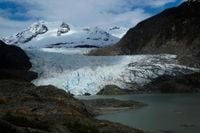In the icy frontiers of the Americas, two of the continent’s most iconic glaciers—Argentina’s Perito Moreno and Alaska’s Mendenhall—are facing crises that underscore the growing unpredictability of Earth’s changing climate. Both sites, renowned for their breathtaking beauty and tourist draw, have become ground zero for dramatic shifts that scientists, local officials, and residents are racing to understand and manage.
In Argentine Patagonia, the Perito Moreno Glacier has long been celebrated as a rare beacon of stability amid a region where most glaciers have steadily retreated. According to a recent study published in Nature, this 30-kilometer ice giant’s thinning rate has surged more than sixteen-fold since 2019, with some sections pulling back by over 800 meters. For nearly two decades, Perito Moreno’s front barely budged—shifting less than 100 meters between 2000 and 2019—thanks to a submerged ridge in Lago Argentino that acted as a natural anchor. But, as of 2019, this stability has been upended, and the glacier is now in rapid decline.
Satellite and aerial radar surveys, including two helicopter-based missions led by Moritz Koch in March 2022, have confirmed that the glacier’s terminus is thinning at an average of 5.5 meters per year. The culprit? A complex interplay of warming temperatures, shifting precipitation patterns, and possibly local underwater dynamics that have accelerated the glacier’s retreat. The once-reliable ridge beneath the glacier—its geological lifeline—now teeters on the brink of losing its grip. If the glacier’s front retreats just a few hundred meters more, it will slip into deeper waters, exposing itself to more aggressive undercutting by lake water and dramatically increasing iceberg calving.
Researchers warn that if Perito Moreno detaches from this ridge, the consequences could be swift and severe. The glacier could retreat several kilometers in just a few years, a scenario that would inject massive volumes of freshwater and ice into Lago Argentino. This would not only disrupt boat navigation—a vital component of the region’s tourism economy—but also alter nutrient cycles, with ripple effects on the lake’s aquatic life. The glacier, a UNESCO World Heritage Site since 1981 and a symbol of resilience, would instead become a stark visual testament to the accelerating decline of the world’s ice fields.
“The stable balance between accumulation and melting has been disrupted, and researchers are now racing to determine the underlying causes,” Nature reported. The uncertainty is palpable: while thinning rates and retreat data suggest an inevitable detachment if current trends persist, scientists can’t say whether this will unfold over years or decades. The unpredictable mix of climate variables and underwater topography has left the timeline for collapse frustratingly unclear.
With so much at stake, the scientific community is calling for more frequent monitoring, expanded radar mapping, and detailed modeling to better predict and possibly mitigate the glacier’s fate. Local authorities and conservationists face mounting pressure to adapt park management and tourism infrastructure to a rapidly changing landscape.
Thousands of kilometers north, in Alaska’s capital city of Juneau, residents and officials are grappling with a different but equally daunting glacial challenge. On August 8, 2025, the city braced for the latest in a series of annual floods caused by the Mendenhall Glacier acting as an ice dam. Since 2011, these so-called glacier outburst floods have become a regular threat, with the potential to sweep away houses, damage hundreds of homes, and erode the Mendenhall River’s banks.
The mechanics are deceptively simple: each spring and summer, a basin behind the retreating glacier fills with rainwater and snowmelt. When the pressure builds high enough—sometimes aided by heavy rain or sunshine—the water forces its way under or around the ice dam, surging into Mendenhall Lake and then the river. As of August 8, the water level in the basin stood at 1,353 feet, just 15 feet shy of overtopping the dam, according to Nicole Ferrin of the National Weather Service. “Some days when there’s no rain, it only rises by a foot,” she explained. “Other days when there is heavy rain or a lot of sunshine, it rises by 4 feet, so it’s a variable.”
The unpredictability makes planning a nightmare. In some years, flooding is limited to streets and properties near the lake or river. But the past two years have set new records, with the river cresting at 15.99 feet last August—about a foot higher than the previous year—and nearly 300 residences damaged in 2024 alone. During these major events, up to 15 billion gallons of water can be released—enough to fill nearly 23,000 Olympic-size swimming pools. At its peak, the Mendenhall River’s flow rate has approached half that of Niagara Falls, according to researchers at the University of Alaska Southeast and the Alaska Climate Adaptation Science Center.
City officials, working with state, federal, and tribal partners, have scrambled to defend the community. This year, they installed a temporary levee system—about 10,000 four-foot-tall barriers stretching 2.5 miles along the riverbank—to protect more than 460 properties from a repeat of last year’s devastation. “Once the water tops the dam, the city will set up a hotline where people can get information,” Capital City Fire/Rescue Chief Rich Etheridge told the Associated Press, warning residents to stay away from the river during floods due to the dangers posed by debris.
Yet, for all these efforts, the threat is far from resolved. The U.S. Army Corps of Engineers has only just begun what’s expected to be a yearslong study to explore more permanent solutions. Many residents are frustrated by the slow pace, especially as experts warn that outburst floods will likely continue for another 25 to 60 years—so long as the glacier acts as an ice dam for the basin behind it.
The stories of Perito Moreno and Mendenhall glaciers, while separated by continents, share a common thread: the relentless march of environmental change and the challenges it poses for communities, scientists, and policymakers alike. As both glaciers retreat—one in a sudden, dramatic shift after decades of calm, the other as an annual harbinger of destructive floods—they offer a sobering glimpse of the future facing ice-bound regions worldwide.
For now, the fate of these glaciers hangs in the balance. Whether it’s the looming risk of a multi-kilometer collapse in Patagonia or the unpredictable torrents threatening Juneau, the world is watching—and, for many, hoping that science and preparation can keep pace with a rapidly shifting natural world.




